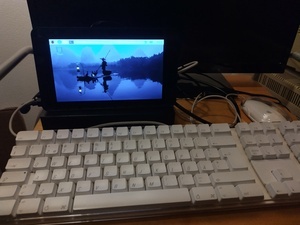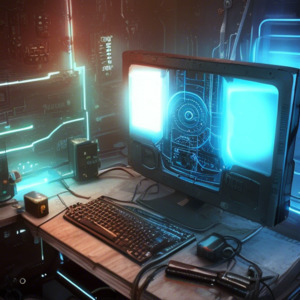

"Let the good times roll."
This is a list of native Commodore 64 programs I have stored on physical floppy disks for the Commodore 1541 drive. I have also backed up all these disks as D64 images elsewhere, so at least in theory they could be rewritten back to new disks using e.g. DiskSumo or a similar tool. Time will tell.
(Click the heading to read more...)
When I tried Stable Diffusion on a low-end PC, I was impressed how easy and cheap it was to get it usable with just a small GPU investment. But after SD 1.5, these models quickly grew insanely and hardware requirements likewise, so I kind of lost interest. It seemed like AI was just a brute-force effort requiring more and more excessive resources.
But at one point, I decided to try out FLUX.1 and was again impressed - not just the highly improved picture quality, but also the fact it was again runnable on a low-end machine. The essence of the story here is quantization - there are versions of models well below 10 GB in size, so they work nicely even with just 16 GB RAM and even less VRAM. They are close to full complete models still.
This time, the only investment I made was M.2 SSD and PCI-E adapter (total cost under 100 e) to bump up the model loading speed from spinning SATA disk's 100 MB/s to 350 MB/s (PCI-E Gen2 x1). Not strictly necessary but was a nicety.
Some examples of quantized model sizes (FLUX.1 Fill Dev):
| Model variant | Size | Load time with NVMe SSD/ext4 |
|---|---|---|
| Full | 22.17 GB | 68 s |
| Q8 | 11.85 GB | 36 s |
| Q5_K_M | 7.85 GB | 24 s |
| Q4_K_M | 6.47 GB | 20 s |
Once loaded, Q5_K_M and Q4_K_M can be kept fully in RAM on a 16 GB machine and they also fit into NVIDIA RTX 3060 12 GB VRAM. Given the fast loading and size there's are the most attractive ones to work with. While the bigger models also work with partial loading, things become just too slow. Quality-wise the smaller ones produce pretty good, comparable results. The Q5_K_M was the most optimal for me, and it was pleasing to be able to just delete and forget the others and free up disk space.
In image generation the iteration speed with 1024x1024 resolution is 4.74s/it (roughly 8 times more compared to SD 1.5) when using AMD-FX-6330 with 16 GB RAM and NVIDIA RTX 3060 12 GB VRAM graphics card (in PCI-E Gen2 x16 slot). The bottleneck here is either the GPU or the PCI-E bus.
But this shows that at least with FLUX models quantization works really well, and less can be more.
(Click the heading to read more...)
When setting up my vintage Bitwoods RBBS-PC, I faced some strange issues when trying to get the old trusty RBBS-PC (compiled using QuickBASIC 4.5) running properly on modern hardware and emulators. It turned out all these problems were 8087 related. I still haven't found the very exact root cause why QB applications fail and produce wrong results on modern environments, I but at least I've found some clues and workarounds that allow me keeping using them.
(Click the heading to read more...)

I wanted to have a small ``portable'' computer that is suitable for word processing and lightweight web browsing (e.g. online banking). I don't like laptops which are non-modular and increasingly non-repairable, so I built a prototype using Raspberry Pi and some spare and recycled items I had around. The inspiration was taken from Commodore 64 executive model that was the first ``luggable'' color computer with a small 5" monitor.
(Click the heading to read more...)

I have used a Huawei E392 modem for my main Internet connection needs since 2016. I've attached it to a Raspberry Pi that acts as a router.
This is an old school modem that appears as a serial device (AT command modem) and PPP is used to run the Internet Protocol. Compared to newer USB modems (that appear as Ethernet devices running their own IP stacks with NAT, Web UIs and whatever other malware), the AT command interface is much more low-level and hackable, as it allows you to both monitor and control some aspects of the radio link.
The modem has turned out to be pretty robust. The ones I bought were already second-handed, and they have been running pretty much 7/24 since (it's now end of 2024). Maybe once a year there's a hang that requires power cycling. The performance is sufficient. I haven't had the need to use an external antenna - in every location in Finland where I've used it, the signal has been good enough.
This article documents some technical low-level stuff that I've found from other sources and/or reverse-engineered.
(Click the heading to read more...)
Some personal records on Atari games.
| Game (and settings) | Switches | High score | Date | Hardware |
|---|---|---|---|---|
| Burning Rubber | 11320 | 2023-10-01 | B0 | |
| Dragster (mode 1) | 6:57 | 2021-01-31 | A0 | |
| Enduro | 416.4 km (3) | 2022-09-06 | A0 | |
| Fatal Run | 22790 | 2022-10-29 | A0 | |
| Indy 500 (Game 2) | BB | 7 | 2021-01-31 | A0 |
| MotoRodeo (Truck, Tires, Easy) | BB | 575 | 2021-10-22 | A0 |
| Night Driver (Game 1) | AB | 52 | 2021-01-10 | A1 |
| Pole Position | 31420 | 2024-12-15 | A0 | |
| Space Invaders | 7609 | 2021-01-31 | A0 | |
| Sprintmaster (Bounce/4 Laps/Track 1/Black) | BB | 0.25:1 | 2021-01-31 | A0 |
(Click the heading to read more...)
THEC64 is a pretty nice Commodore 64 emulator but the UI is a bit clumsy. It assumes that D64 files are ``one disk, one autoloading program''. There's no quick way to browse disk images and lauch a specific program, instead you need to do it manually like back in the day:
Switch to Classic mode. Once booted, press the rightmost joystic special button and select:
Now the disk is activated and you can load the index with:
LOAD "$", 8
And then LIST and load the program you need. Of course this is all quite authentic but maybe they could have provided some kind of faster method for disk browsing...
MIPS.COM is a popular MS-DOS and IBM PC benchmark program from 1980s.
The version of my binary is v1.10, 13312 bytes and the file time stamp is 1987-03-28 (md5sum 2ca6ecb0dbacfb78da35b13ae73aaf8d). No source code is known to be available. However, like with many programs from this era, the disassembly is almost human readable code.
The program has couple annoying cosmetic problems when it's run on a modern PC today, and I have attempted to fix them.
(Click the heading to read more...)
I noticed that when using modern emulators and/or BIOS versions, MS-DOS 3.20 fails to format a hard drive (tested using a 32 MB disk):
A>format c: WARNING, ALL DATA ON NON-REMOVABLE DISK DRIVE C: WILL BE LOST! Proceed with Format (Y/N)?y Format complete Error reading partition table Format failure
The above example was produced using SeaBIOS (1.13.0-1ubuntu1.1) and QEMU (4.2.1 (Debian 1:4.2-3ubuntu6.29)). Depending on BIOS, the returned error may also be ``Bad Partition Table''.
This is interesting given that back-in the day MS-DOS 3.20 was used in millions of computers apparently without such an issue.
After some debugging, it seems the root cause is that FORMAT.EXE is trying read the partition table by passing the (0,0,0) CHS address to INT 13h BIOS read disk routine. The routine assumes that sectors start from 1, so depending on BIOS it either rejects the read or reads data from an incorrect location. Apparently this was somehow working when ``real'' CHS addressing was used. Modern systems that convert it to LBA fail.

Thanks to all the hype in the news and at workplace etc. I got interested in AI and tried out Stable Diffusion. It seemed interesting enough to install it locally (I prefer to be self-hosting in about everything), but the problem was I mostly run old legacy recycled hardware, so modern software is not always running that smoothly...
To run it I installed InvokeAI using their instructions which were pretty straightforward. They support a CPU-only mode so basically you can run it on any old hardware. This is good because you can try it out first to see if it's anything you would like to ever use, before splashing money on a GPU.
I was impressed, and a after a few days of experimenting I was confident enough to invest in some new hardware.
(Click the heading to read more...)
[Computers] [Records] [Bootlegs] [Movies] [Books]
Send e-mail to Aaro Koskinen <aaro.koskinen@iki.fi> or leave a note at Bitwoods RBBS-PC.
Last updated: 2025-10-25 22:52 (EEST)